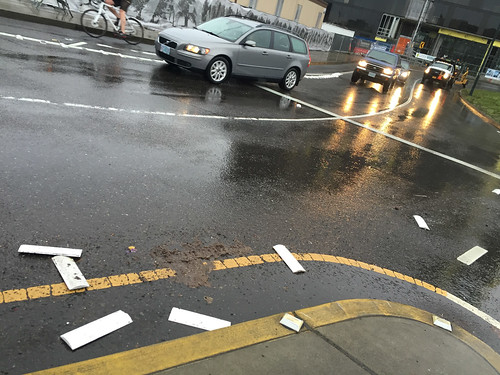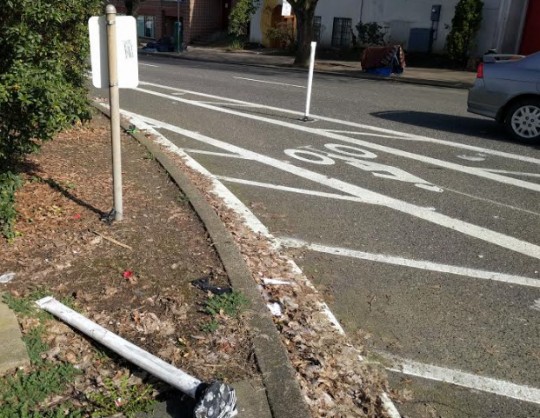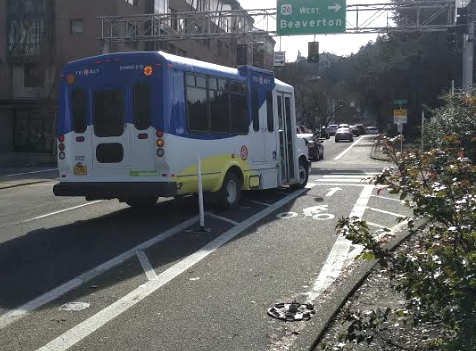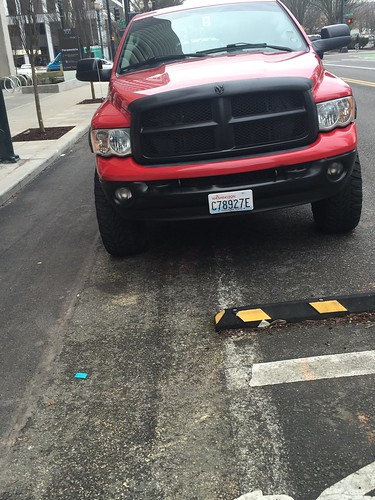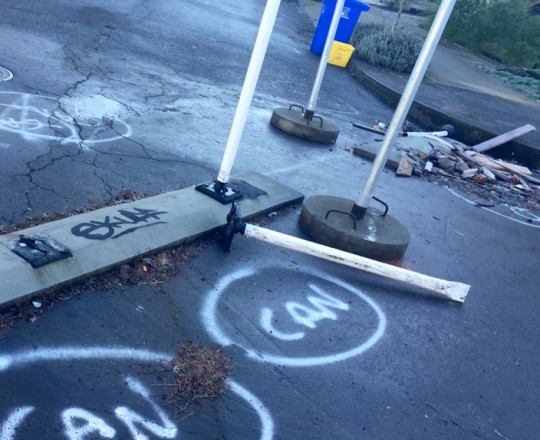
(Photo sent in by a reader)
Every time we turn around we hear another city staffer or elected official tell us how serious they are about cycling. They say it’s key to our health outcomes, it’s the only way we’ll reach our climate change goals, it buoys our national reputation, and so on and so forth.
But if we’re really serious about cycling, why don’t we take our cycling infrastructure seriously?
There are too many examples in Portland where the design and implementation of our cycling infrastructure has not been completed with the care and seriousness it deserves.
Here are a few of those examples:
Northeast Couch at the Burnside Bridge
The City of Portland’s Bureau of Transportation has known for years that the design of Northeast Couch as it approaches the Burnside Bridge is dangerous. The problem is that people in cars cut the s-curve and drive in the bike lane. Their latest attempt to fix the problem was to glue “rumble bars” to the pavement in hopes that the jarring noise would alert clueless vehicle operators. That attempt failed miserably. Today only a few of the bars remain and the rest are scattered all over the street.
Southwest 13th at Clay
In another attempt to protect bicycle riders from dangerous driving behaviors, in January PBOT installed plastic wands to separate the bike lane on Southwest 13th as it approaches Clay. Within a few hours of installation a wand had been ripped out by a careless driver. As of today just one wand remains.
Northwest Lovejoy ramp toward 9th
In December 2011 PBOT installed plastic wands to help separate the downhill bike lane on NW Lovejoy (westbound on the ramp toward 9th) from the adjacent lane. After streetcar tracks went in, many people in cars drove in the bike lane to avoid driving on them. Just four days later, many of the wands had been ripped up by people who lacked the skill and/or respect to maintain their lane of travel. One month later they were re-installed. Then a few days later they were ripped up once again.
PBOT ultimately gave up and has never even attempted to replace this safe cycling infrastructure.
Advertisement
Northeast Multnomah
The bikeway on Northeast Multnomah is often held up as PBOT’s best “protected” bike lane in the entire city. Unfortunately it’s become so tattered and unkempt since it debuted in 2012 that it’s merely a shell of its former self. Much of the bold “beeswax” paint is gone, all the plastic wands have long been ripped out and never replaced, and even the massive concrete planter boxes have been hit and damaged and moved around. This lack of maintenance is even more troublesome because it’s been almost two years since the project’s task force agreed to make this bikeway permanent.
Northeast Rodney at Ivy
In order to preserve a low-stress cycling environment on Northeast Rodney (a key parallel bikeway that complements North Williams Avenue), PBOT decided to put a traffic diverter at Ivy. That diverter was installed 17 months ago. Just a month after it went in, the design was so meager that many people simply ignored it and drove right through it. Today PBOT still hasn’t done anything to improve the design. Most of the plastic wands are on the ground and people are dumping trash around it. In the words of a reader who lives in the area, “It’s a big, gross mess.”
It’s very important that we get this right.
There are real safety risks to consider. Because nearly all cycling infrastructure in Portland is still created with only paint and plastic, it stops working when either one of those things goes away. In every example above, the dangerous behaviors PBOT tried to stop have started up again.
But beyond a lack of effectiveness, there’s something equally troubling. This lack of seriousness is a signal to all Portlanders about our priorities. When bike infrastructure is allowed to decay it tells everyone we’re not willing to invest the time and care it takes to make it work and we ultimately don’t care about the people who use it.
I know we can do a better job at this. Let’s do it. Seriously.
— Jonathan Maus, (503) 706-8804 – jonathan@bikeportland.org
BikePortland can’t survive without paid subscribers. Please sign up today.


